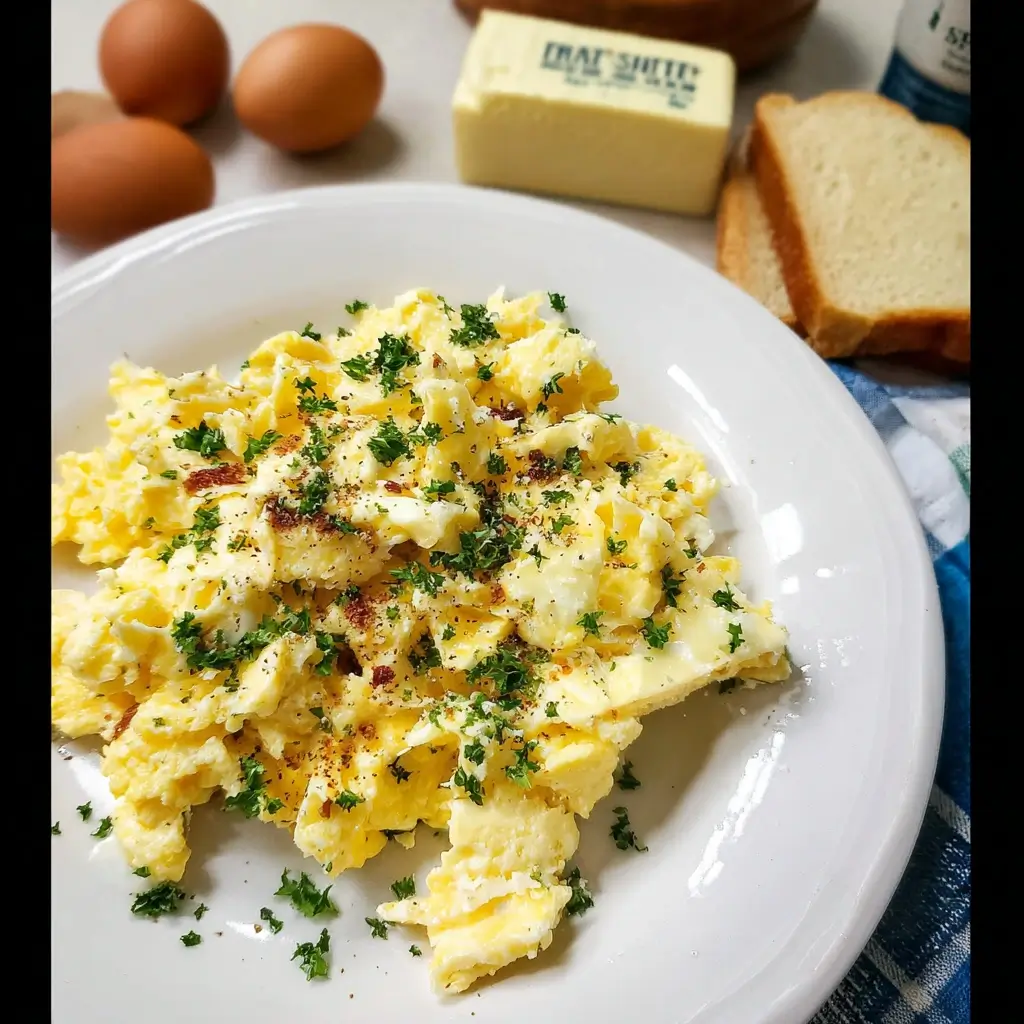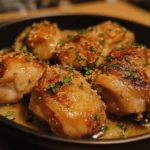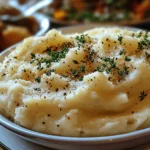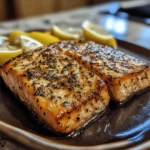Of all the simple luxuries in the culinary world, few can rival the experience of a perfectly executed plate of truffle scrambled eggs. I still remember the first time I decided to elevate our standard Saturday morning breakfast. The kids were expecting their usual, slightly-overcooked-the-way-they-like-them scrambled eggs, and my husband was just happy for a slow morning with coffee. But I had a secret weapon: a small, precious bottle of black truffle oil I’d been saving for a special occasion. As the creamy, custardy eggs came together in the pan, I drizzled in the oil just before serving. The change in the kitchen’s aroma was instantaneous and electrifying. It went from the familiar, comforting smell of butter and eggs to something deeply earthy, mysterious, and utterly intoxicating. The silence at the breakfast table, followed by wide-eyed looks of astonishment, said it all. It was no longer just breakfast; it was an event. That simple meal transformed our ordinary weekend into a memorable feast, proving that a touch of truffle can turn the most humble ingredients into pure, edible gold. This recipe is the culmination of many such weekend experiments, perfected to deliver that same “wow” moment every single time.
The Ultimate Truffle Scrambled Eggs: A Decadent Delight
This recipe is designed to produce rich, creamy, and custardy scrambled eggs where the truffle is the star of the show. We will walk through not just the steps, but the why behind each technique, ensuring you achieve a gourmet, restaurant-quality result in your own kitchen.
The Cast of Ingredients: Quality is Key
The beauty of this dish lies in its simplicity, which means the quality of each component is paramount. There’s nowhere for a sub-par ingredient to hide.
- Large Eggs: 4, preferably organic and pasture-raised. The deep orange yolks of high-quality eggs lend a richer flavor and a beautiful golden color to the final dish.
- Heavy Cream: 2 tablespoons. This is the secret to a luxuriously creamy, custard-like texture. You can substitute with crème fraîche for a slightly tangy finish or whole milk for a lighter version.
- Unsalted Butter: 1 tablespoon, high-quality. Using unsalted butter allows you to control the final salinity of the dish perfectly.
- Fine Sea Salt: ¼ teaspoon, or to taste. Fine salt dissolves more easily and seasons the eggs evenly.
- Freshly Ground Black Pepper: ⅛ teaspoon, or to taste. The pungent kick of fresh pepper cuts through the richness of the eggs and cream.
- Fresh Chives: 1 tablespoon, finely chopped. Their delicate, oniony bite provides a fresh contrast to the earthy truffle and rich eggs.
- Your Truffle Element of Choice:
- Option 1 (The Gold Standard): 1 small fresh black truffle (about 5-7 grams), for shaving.
- Option 2 (Excellent & Accessible): 1 to 2 teaspoons of high-quality Black or White Truffle Oil. Be sure to use one made with real truffle infusion, not just “truffle aroma.”
- Option 3 (A Flavorful Shortcut): ½ teaspoon of Truffle Salt, used in place of regular salt.
- Option 4 (Rich & Creamy): 1 tablespoon of Truffle Butter, used in place of regular butter.
Step-by-Step Instructions to Creamy Perfection
The technique is as important as the ingredients. The key to creamy, soft-scrambled eggs is patience and gentle, low heat. Rushing the process with high heat will result in tough, rubbery eggs.
Part 1: The Preparation
- Crack the Eggs: Crack your 4 large eggs into a medium-sized bowl. Cracking them into a separate bowl first is a professional habit that ensures no stray eggshell pieces make it into your final dish and allows you to easily remove a bad egg if you encounter one.
- Whisk with Purpose: Add the 2 tablespoons of heavy cream, ¼ teaspoon of fine sea salt, and ⅛ teaspoon of freshly ground black pepper to the bowl with the eggs. Whisk vigorously for about 30-45 seconds. You are looking for a homogenous, pale yellow mixture with no visible streaks of egg white or yolk. This process incorporates a bit of air for a lighter texture and ensures even cooking and seasoning. Do not add your truffle oil or shavings at this stage; their delicate flavors will be diminished by the heat.
- Prepare the Pan: Place a high-quality non-stick skillet or a well-seasoned carbon steel pan over low heat. It is absolutely crucial that the heat is low. If your stove runs hot, use the smallest burner on its lowest setting. Add the 1 tablespoon of unsalted butter and allow it to melt slowly and gently. It should be just melted and foamy, not sizzling or browning.
Part 2: The Gentle Cook
- Pour and Wait: Once the butter is melted, pour the whisked egg mixture into the pan. Let it sit, undisturbed, for about 30-60 seconds, until you see the very edges just beginning to set.
- The Slow Scramble: Using a silicone or rubber spatula (to avoid scratching your non-stick pan), begin to slowly push the eggs from the edge of the pan toward the center. Tilt the pan to allow the uncooked egg to flow into the empty space. Continue this long, slow pushing motion around the entire pan. This method creates large, soft, delicate curds instead of small, crumbly pieces.
- Patience is a Virtue: Continue cooking over low heat, constantly and gently stirring and folding the eggs. This process should take several minutes (anywhere from 5 to 8 minutes). The eggs will slowly transform from a liquid to a creamy, custardy, slightly thickened consistency, similar to a very loose porridge.
- The Critical Moment: The most important step is to remove the pan from the heat before the eggs look fully cooked. They should still appear slightly wet and underdone. The residual heat in the pan will continue to cook them to perfection, a phenomenon known as carryover cooking. If you wait until they look done in the pan, they will be overcooked and dry by the time they reach the plate.
Part 3: The Finishing Touch – Infusing the Truffle
- Add the Truffle: Once the pan is off the heat, it’s time to add the magic.
- If using truffle oil: Drizzle 1-2 teaspoons of truffle oil over the eggs.
- If using truffle salt: If you haven’t already salted, this is the time to add it.
- If using truffle butter: If you haven’t used it for cooking, stir in a small knob now.
- Fold and Finish: Gently fold the eggs one or two more times to incorporate the truffle element and the fresh chives. The warmth of the eggs will release the truffle’s intoxicating aroma.
- Serve Immediately: Scrambled eggs wait for no one. Plate them immediately to enjoy them at their peak texture and temperature. If using fresh truffle, now is the time to use a truffle shaver or a very sharp mandoline to shave generous slivers over the top of the plated eggs. The visual and aromatic effect is second to none.
Nutrition Facts
- Servings: 2
- Calories per serving: Approximately 350-400 kcal (This can vary based on the quality of eggs, fat content of the cream, and the amount of butter and truffle oil used).
Preparation Time
- Prep Time: 5 minutes
- Cook Time: 8-10 minutes
- Total Time: Approximately 15 minutes
This quick turnaround makes it a feasible recipe for a special weekday breakfast or a stress-free weekend brunch centerpiece.
How to Serve Your Truffle Scrambled Eggs
Serving these eggs with the right accompaniments will elevate them from a simple dish to a complete culinary experience. The goal is to complement the rich, earthy flavors without overpowering them.
Classic & Elegant Presentation
For a simple yet sophisticated serving style that lets the eggs shine:
- On Toast: Serve a generous pile of the creamy eggs on a thick slice of toasted artisan bread.
- Sourdough: The tangy flavor provides a wonderful contrast to the richness of the eggs.
- Brioche: The slightly sweet, buttery bread doubles down on the decadent nature of the dish.
- Whole Grain: A hearty, nutty bread provides a rustic and textural counterpoint.
- With a Green Garnish: A simple side of lightly dressed arugula or watercress with a lemon vinaigrette can cut through the richness and cleanse the palate.
The Ultimate Brunch Plate
Build a more substantial meal around the eggs for a show-stopping brunch:
- Protein Pairings:
- Smoked Salmon: Drape a few slices of high-quality smoked salmon alongside the eggs.
- Prosciutto or Pancetta: Add thin slices of salty, savory cured meat. Crispy pancetta adds a wonderful textural crunch.
- Sausages: Serve with gourmet breakfast sausages, such as pork and apple or chicken and herb.
- Vegetable Accompaniments:
- Sautéed Mushrooms: Enhance the earthy notes by serving with mushrooms sautéed in garlic and thyme.
- Roasted Asparagus: Tender spears of roasted asparagus drizzled with a little olive oil make a perfect companion.
- Slow-Roasted Tomatoes: Sweet, jammy roasted cherry or plum tomatoes add a burst of acidity and color.
Luxurious & Appetizer-Style
For a passed hors d’oeuvre at a party or a multi-course tasting menu:
- In Pastry: Spoon the truffle scrambled eggs into small, pre-baked puff pastry shells (vol-au-vents) or on top of mini blinis.
- On Crostini: Serve a small dollop on a toasted baguette slice (crostini) that has been rubbed with a garlic clove.
- With Caviar: For the ultimate indulgence, top the finished eggs with a tiny spoonful of high-quality caviar. The briny pop of the caviar is an incredible contrast to the creamy, earthy eggs.
Additional Tips for Truffle Egg Mastery
- Low and Slow is the Unbreakable Rule: This cannot be overstated. High heat causes the proteins in eggs to bond tightly, squeezing out water and resulting in a firm, rubbery texture. Low heat allows the proteins to set gently, creating a creamy, tender curd that holds onto its moisture. If you think the heat is too low, it’s probably just right.
- Master the “Bain-Marie” Method for Ultimate Creaminess: For the most foolproof, velvety eggs imaginable, cook them in a double boiler (or a heatproof bowl set over a saucepan of simmering water, not boiling). This method provides the gentlest heat possible, making it nearly impossible to overcook them. It takes longer (15-20 minutes), but the result is an incredibly smooth, sauce-like scramble that is pure luxury.
- Don’t Season with Salt Too Early: While we add salt just before whisking in this recipe, some chefs swear by salting only at the very end. The theory is that salting the raw eggs and letting them sit can break down the proteins prematurely, leading to a slightly watery final product. If you ever find your eggs are a bit weepy, try salting them just as you take them off the heat.
- Understand Your Truffle Products:
- Fresh Truffle: The ultimate luxury. Its aroma is complex and fleeting. Always add it at the end, shaved over the warm eggs to release its scent. For an even deeper flavor, store your eggs in an airtight container with a fresh truffle for a day or two before cooking; the porous eggshells will absorb the aroma.
- Truffle Oil: The most common choice. Quality varies wildly. Avoid oils that list “truffle aroma” or “essence” as an ingredient, as this is typically a synthetic chemical (2,4-dithiapentane). Look for oils made with real truffle pieces steeped in high-quality olive oil. White truffle oil is more pungent and peppery, while black truffle oil is more earthy and robust.
- Truffle Salt/Butter: These are excellent, accessible alternatives. They provide a genuine truffle flavor that is more balanced and less prone to the “chemical” taste of bad truffle oil.
- Embrace the Carryover Heat: This is a fundamental concept in all cooking, but it’s especially important with delicate foods like eggs. Food continues to cook even after it’s removed from the direct heat source. By pulling your eggs off the stove when they look about 90% done (still soft, wet, and glistening), you are letting the pan’s residual heat gently guide them to a perfect, creamy finish on the way to the plate. This single tip is the main difference between good scrambled eggs and great ones.
Frequently Asked Questions (FAQ)
1. Can I make this recipe dairy-free?
Absolutely. For a dairy-free version, you can substitute the heavy cream with a rich, unsweetened plant-based milk like oat milk or a plain nut-based coffee creamer for a similar creamy effect. For the butter, use a high-quality dairy-free butter substitute or a flavorful olive oil. The texture will be slightly different but still delicious.
2. My eggs always turn out dry and rubbery. What am I doing wrong?
The most likely culprit is heat. If your pan is too hot, the eggs will cook too quickly, resulting in that classic rubbery texture. The solution is to turn your stove down to its lowest possible setting. The cooking process should feel slow and controlled. The second cause could be overcooking. Remember to pull the pan off the heat while the eggs still look a little wet, as they will continue to set.
3. Fresh truffles are so expensive! What is the best and most cost-effective alternative to get real truffle flavor?
While fresh truffles are a splurge, you can still achieve a fantastic flavor with other products. The best cost-effective alternative is widely considered to be high-quality truffle butter or truffle salt. These products are typically made with real truffle pieces and offer a more authentic and less overpowering flavor than many commercial truffle oils. A small jar can last a long time and can be used in many other dishes.
4. Can I make truffle scrambled eggs ahead of time?
It is highly recommended to serve scrambled eggs immediately after cooking for the best texture and flavor. They tend to become firm and can release water as they cool. If you absolutely must make them ahead, slightly undercook them even more than usual. To reheat, do so very gently in a non-stick pan over low heat with a tiny bit of extra butter, stirring constantly until just warmed through. Avoid the microwave, as it will make them rubbery.
5. What is the real difference between black truffle and white truffle products?
Black truffles and white truffles are different species with distinct flavor profiles.
- Black Truffle: Has a more robust, earthy, and chocolatey aroma. It is slightly more resilient to heat, which is why it’s sometimes used in cooking processes. Black truffle oil or salt provides a deep, musky, and savory flavor.
- White Truffle: Is rarer and generally more expensive. It has a much more delicate and pungent aroma with notes of garlic, shallot, and pepper. Its flavor is highly volatile and is almost always used as a finishing element, shaved raw or infused into oils to be drizzled just before serving. For this recipe, either works beautifully, but they will give you a different aromatic experience.
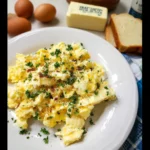
Truffle Scrambled Eggs Recipe
Ingredients
- Large Eggs: 4, preferably organic and pasture-raised. The deep orange yolks of high-quality eggs lend a richer flavor and a beautiful golden color to the final dish.
- Heavy Cream: 2 tablespoons. This is the secret to a luxuriously creamy, custard-like texture. You can substitute with crème fraîche for a slightly tangy finish or whole milk for a lighter version.
- Unsalted Butter: 1 tablespoon, high-quality. Using unsalted butter allows you to control the final salinity of the dish perfectly.
- Fine Sea Salt: ¼ teaspoon, or to taste. Fine salt dissolves more easily and seasons the eggs evenly.
- Freshly Ground Black Pepper: ⅛ teaspoon, or to taste. The pungent kick of fresh pepper cuts through the richness of the eggs and cream.
- Fresh Chives: 1 tablespoon, finely chopped. Their delicate, oniony bite provides a fresh contrast to the earthy truffle and rich eggs.
- Your Truffle Element of Choice:
- Option 1 (The Gold Standard): 1 small fresh black truffle (about 5–7 grams), for shaving.
- Option 2 (Excellent & Accessible): 1 to 2 teaspoons of high-quality Black or White Truffle Oil. Be sure to use one made with real truffle infusion, not just “truffle aroma.”
- Option 3 (A Flavorful Shortcut): ½ teaspoon of Truffle Salt, used in place of regular salt.
- Option 4 (Rich & Creamy): 1 tablespoon of Truffle Butter, used in place of regular butter.
Instructions
Part 1: The Preparation
- Crack the Eggs: Crack your 4 large eggs into a medium-sized bowl. Cracking them into a separate bowl first is a professional habit that ensures no stray eggshell pieces make it into your final dish and allows you to easily remove a bad egg if you encounter one.
- Whisk with Purpose: Add the 2 tablespoons of heavy cream, ¼ teaspoon of fine sea salt, and ⅛ teaspoon of freshly ground black pepper to the bowl with the eggs. Whisk vigorously for about 30-45 seconds. You are looking for a homogenous, pale yellow mixture with no visible streaks of egg white or yolk. This process incorporates a bit of air for a lighter texture and ensures even cooking and seasoning. Do not add your truffle oil or shavings at this stage; their delicate flavors will be diminished by the heat.
- Prepare the Pan: Place a high-quality non-stick skillet or a well-seasoned carbon steel pan over low heat. It is absolutely crucial that the heat is low. If your stove runs hot, use the smallest burner on its lowest setting. Add the 1 tablespoon of unsalted butter and allow it to melt slowly and gently. It should be just melted and foamy, not sizzling or browning.
Part 2: The Gentle Cook
- Pour and Wait: Once the butter is melted, pour the whisked egg mixture into the pan. Let it sit, undisturbed, for about 30-60 seconds, until you see the very edges just beginning to set.
- The Slow Scramble: Using a silicone or rubber spatula (to avoid scratching your non-stick pan), begin to slowly push the eggs from the edge of the pan toward the center. Tilt the pan to allow the uncooked egg to flow into the empty space. Continue this long, slow pushing motion around the entire pan. This method creates large, soft, delicate curds instead of small, crumbly pieces.
- Patience is a Virtue: Continue cooking over low heat, constantly and gently stirring and folding the eggs. This process should take several minutes (anywhere from 5 to 8 minutes). The eggs will slowly transform from a liquid to a creamy, custardy, slightly thickened consistency, similar to a very loose porridge.
- The Critical Moment: The most important step is to remove the pan from the heat before the eggs look fully cooked. They should still appear slightly wet and underdone. The residual heat in the pan will continue to cook them to perfection, a phenomenon known as carryover cooking. If you wait until they look done in the pan, they will be overcooked and dry by the time they reach the plate.
Part 3: The Finishing Touch – Infusing the Truffle
- Add the Truffle: Once the pan is off the heat, it’s time to add the magic.
- If using truffle oil: Drizzle 1-2 teaspoons of truffle oil over the eggs.
- If using truffle salt: If you haven’t already salted, this is the time to add it.
- If using truffle butter: If you haven’t used it for cooking, stir in a small knob now.
- Fold and Finish: Gently fold the eggs one or two more times to incorporate the truffle element and the fresh chives. The warmth of the eggs will release the truffle’s intoxicating aroma.
- Serve Immediately: Scrambled eggs wait for no one. Plate them immediately to enjoy them at their peak texture and temperature. If using fresh truffle, now is the time to use a truffle shaver or a very sharp mandoline to shave generous slivers over the top of the plated eggs. The visual and aromatic effect is second to none.
Nutrition
- Serving Size: One Normal Portion
- Calories: 350-400


